

Modern behavior of early humans found half-million years earlier than previously thought. Evidence of sophisticated, human behavior has been discovered by Hebrew University of Jerusalem researchers as early as 750,000 years ago -- some half a million years earlier than has previously been estimated by archaeologists.

The discovery was made in the course of excavations at the prehistoric Gesher Benot Ya'aqov site, located along the Dead Sea rift in the southern Hula Valley of northern Israel, by a team from the Hebrew University Institute of Archaeology. Analysis of the spatial distribution of the findings there reveals a pattern of specific areas in which various activities were carried out. This kind of designation indicates a formalized conceptualization of living space, requiring social organization and communication between group members.
Such organizational skills are thought to be unique to modern humans. 'Inhabitants of Madrid' ate elephants’ meat and bone marrow 80,000 years ago. Humans that populated the banks of the river Manzanares (Madrid, Spain) during the Middle Palaeolithic (between 127,000 and 40,000 years ago) fed themselves on pachyderm meat and bone marrow.
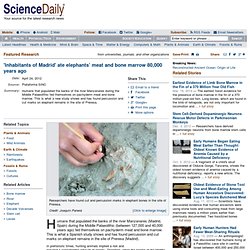
This is what a Spanish study shows and has found percussion and cut marks on elephant remains in the site of Preresa (Madrid). In prehistoric times, hunting animals implied a risk and required a considerable amount of energy. Therefore, when the people of the Middle Palaeolithic (between 127,000 and 40,000 years ago) had an elephant in the larder, they did not leave a scrap. Humans that populated the Madrid region 84,000 years ago fed themselves on these prosbocideans' meat and they consumed their bone marrow, according to this new study. Possible brucellosis in an early hominin skeleton f... [PLoS One. 2009. Africa's Homo sapiens were the first techies. The search for the origin of modern human behaviour and technological advancement among our ancestors in southern Africa some 70,000 years ago has taken a step closer to firmly establishing Africa, and especially South Africa, as the primary centre for the early development of human behaviour.
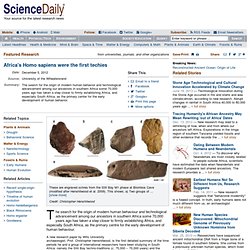
A new research paper by Wits University archaeologist, Prof. Neanderthal 'Family' Possibly Victim of Cannibal Attack. First Direct Evidence Of Substantial Fish Consumption By Early Modern Humans In China 40,000 Years Ago. Early Agriculture Left Traces In Animal Bones. Unraveling the origins of agriculture in different regions around the globe has been a challenge for archeologists.

Now researchers writing in the Proceedings of the National Academy of Sciences report finding evidence of early human experiments with grain cultivation in East Asia. They gathered this information from an unlikely source―dog and pig bones. The dog and pig bones, as well as bones of other animals analyzed in the study, come from an archaeological site in a region of northwest China considered to be a possible early center of East Asian agriculture. Chemical traces within the dog bones suggest a diet high in millet, a grain that wild dogs are unlikely to eat in large quantities, but that was a staple of early agricultural societies in northwest China.
To address this question, the researchers turned to a technique known as stable isotope analysis. True causes for extinction of cave bear revealed: More human expansion than climate change. Skeletons in cave reveal Mediterranean secrets. Skeletal remains in an island cave in Favignana, Italy, reveal that modern humans first settled in Sicily around the time of the last ice age and despite living on Mediterranean islands, ate little seafood.

The research is published November 28 in the open access journal PLOS ONE by Marcello Mannino and colleagues from the Max Planck Institute for Evolutionary Anthropology, Germany. Genetic analysis of the bones discovered in caves on the Egadi islands provides some of the first mitochondrial DNA data available for early humans from the Mediterranean region, a crucial piece of evidence in ancestry analysis. This analysis reveals the time when modern humans reached these islands. First clear evidence of organized feasting by early humans. Community feasting is one of the most universal and important social behaviors found among humans.

Last Neanderthals of southern Iberia may not have coexisted with modern humans, new data suggest. The theory that the last Neanderthals -- Homo neanderthalensis -- persisted in southern Iberia at the same time that modern humans -Homo sapiens- advanced in the northern part of the peninsula, has been widely accepted by the scientific community during the last twenty years.
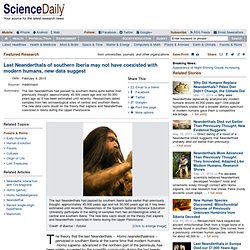
Did Neanderthals make jewellery after all? The theory that later Neanderthals might have been sufficiently advanced to fashion jewellery and tools similar to those of incoming modern humans has suffered a setback.
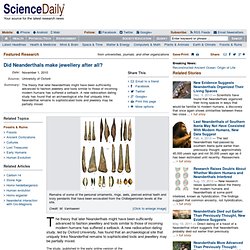
A new radiocarbon dating study, led by Oxford University, has found that an archaeological site that uniquely links Neanderthal remains to sophisticated tools and jewellery may be partially mixed. Last Neanderthals near the Arctic Circle? Remains found near the Arctic Circle characteristic of Mousterian culture(1) have recently been dated at over 28,500 years old, which is more than 8,000 years after Neanderthals are thought to have disappeared.
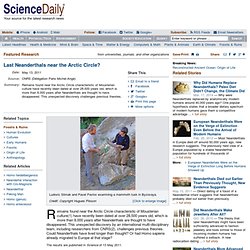
This unexpected discovery by an international multi-disciplinary team, including researchers from CNRS(2), challenges previous theories. Could Neanderthals have lived longer than thought? Or had Homo sapiens already migrated to Europe at that stage? Upper paleolithic ibex hunting in southwest Europe. Gnawed Bones Reveal Cannibal Cavemen. Prehistoric humans may have gnawed on each other's bones, researchers now suggest.
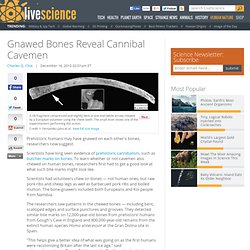
Scientists have long seen evidence of prehistoric cannibalism, such as butcher marks on bones. To learn whether or not cavemen also chewed on human bones, researchers first had to get a good look at what such bite marks might look like. Scientists had volunteers chew on bones — not human ones, but raw pork ribs and sheep legs as well as barbecued pork ribs and boiled mutton. The bone-gnawers included both Europeans and Koi people from Namibia. The researchers saw patterns in the chewed bones — including bent, scalloped edges and surface punctures and grooves. "This helps give a better idea of what was going on as the first humans were recolonizing Britain after the last ice age," said paleoanthropologist Briana Pobiner at the Smithsonian Institution, who did not take part in this study.
Not all of these bite marks are unique to people. Skilled hunters 300,000 years ago. Finds from early stone age site in north-central Germany show that human ingenuity is nothing new -- and was probably shared by now-extinct species of humans. Archeologists from the University of Tübingen have found eight extremely well-preserved spears -- an astonishing 300,000 years old, making them the oldest known weapons anywhere. The spears and other artifacts as well as animal remains found at the site demonstrate that their users were highly skilled craftsmen and hunters, well adapted to their environment -- with a capacity for abstract thought and complex planning comparable to our own. It is likely that they were members of the species Homo heidelbergensis, although no human remains have yet been found at the site. The project is headed by Prof.
Nicholas Conard and the excavations are supervised by Dr. Early Human Hunters Had Fewer Meat-sharing Rituals. A University of Arizona anthropologist has discovered that humans living at a Paleolithic cave site in central Israel between 400,000 and 250,000 years ago were as successful at big-game hunting as were later stone-age hunters at the site, but that the earlier humans shared meat differently. "The Lower Paleolithic (earlier) hunters were skilled hunters of large game animals, as were Upper Paleolithic (later) humans at this site," UA anthropology professor Mary C.
Stiner said. "This might not seem like a big deal to the uninitiated, but there's a lot of speculation as to whether people of the late Lower Paleolithic were able to hunt at all, or whether they were reduced to just scavenging," Stiner said. Archaeologists identify oldest spear points: Used in hunting half-million years ago. Meat eating 45,000 years ago. Butchering Circa 10,000 B.C. Big-game hunts about 12,000 years ago involved feasting on a meaty morsel popular with today’s gourmets, followed by chopping, hauling, bone tossing, jewelry making and boasting.